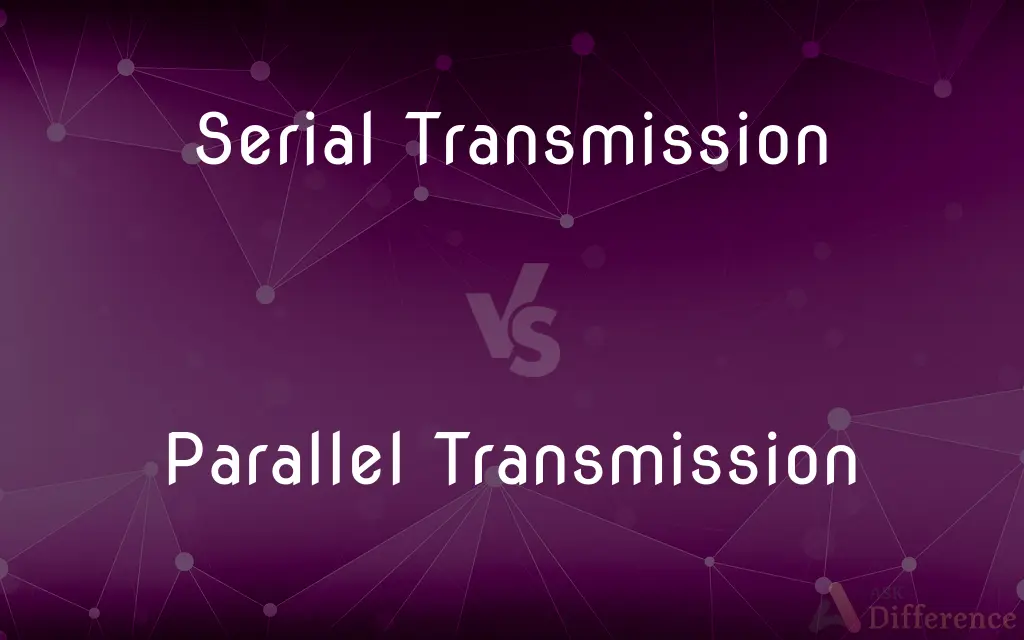Serial Transmission vs. Parallel Transmission — What's the Difference?
By Tayyaba Rehman — Published on January 18, 2024
Serial Transmission sends data bit by bit over a single channel, slower but reliable over longer distances. Parallel Transmission sends multiple bits simultaneously through separate channels, faster but prone to signal interference over shorter distance.

Difference Between Serial Transmission and Parallel Transmission
Table of Contents
ADVERTISEMENT
Key Differences
Serial Transmission sends data one bit at a time, suitable for longer distances, but slower due to sequential sending. Parallel Transmission transmits multiple bits simultaneously, faster for short distances, but complexity increases with channels used.
In Serial Transmission, data travels serially through a single path, making it suitable for long-distance communication like telecommunication. Parallel Transmission sends multiple bits at once through separate paths, ideal for shorter distances within a computer's internal circuits.
Serial Transmission uses fewer physical connections, making it cost-effective for long-distance communication but slower due to its sequential nature. Parallel Transmission's multiple channels provide higher speeds but can suffer from synchronization issues and signal interference over shorter distances.
Serial Transmission's simplicity aids in easier implementation and is more resistant to noise interference, making it reliable for long-distance communication. Parallel Transmission's complexity requires precise synchronization among channels and is susceptible to signal degradation over shorter distances.
Serial Transmission's bit-by-bit transfer ensures more stable signal integrity but lacks the speed of Parallel Transmission's simultaneous transfer of multiple bits, which is more prone to signal distortion and crosstalk among channels.
ADVERTISEMENT
Comparison Chart
Data Transmission
Sends data bit by bit over a single channel
Sends multiple bits simultaneously through separate channels
Speed vs. Distance
Slower but more reliable over longer distances
Faster but prone to interference over shorter distances
Complexity
Simpler with fewer connections
More complex with multiple channels
Communication Application
Suitable for long-distance communication like telecommunication
Ideal for short distances within a computer's internal circuits
Signal Integrity
More stable signal integrity due to sequential sending
Prone to signal distortion and crosstalk among channels
Compare with Definitions
Serial Transmission
Transfers data sequentially, suitable for telecommunication.
Telecommunication networks often rely on serial transmission.
Parallel Transmission
Ideal for short distances within computer circuitry.
Internal circuits benefit from parallel transmission's speed.
Serial Transmission
Ideal for long-distance communication due to its reliability.
Serial transmission ensures data integrity over vast networks.
Parallel Transmission
Multiple channels transfer data simultaneously.
Parallel transmission enhances data transfer rates in devices.
Serial Transmission
Slower but more stable for sending data over extended distances.
Serial transmission ensures reliable data transfer in remote areas.
Parallel Transmission
Faster but susceptible to signal interference.
Parallel transmission speeds up data transfer within systems.
Serial Transmission
Sends data bit by bit over a single channel.
The modem uses serial transmission to communicate data.
Parallel Transmission
Transfers data in parallel paths, useful for high-speed transfers.
High-speed buses employ parallel transmission for quick data exchange.
Serial Transmission
Sends data in a series, suitable for point-to-point communication.
Serial transmission is efficient for point-to-point connections.
Parallel Transmission
Sends multiple bits simultaneously through separate channels.
Computers use parallel transmission for faster internal data transfer.
Common Curiosities
Can serial transmission be used within a computer?
Yes, but its sequential nature makes it slower for internal computer operations compared to parallel transmission.
Why is parallel transmission not ideal for long-distance communication?
Over longer distances, synchronization among multiple channels becomes challenging, leading to signal degradation.
How does serial transmission impact hardware complexity?
Serial transmission's simpler single-channel setup reduces hardware complexity, making it cost-effective for long-distance communication.
How does parallel transmission affect power consumption?
Parallel transmission typically consumes more power due to the simultaneous operation of multiple channels compared to serial transmission.
Is serial transmission less susceptible to signal interference?
Yes, due to its single-channel nature, serial transmission is more resistant to signal interference compared to parallel transmission.
Can serial transmission handle bidirectional data flow?
Yes, serial transmission supports bidirectional communication using a single channel for both sending and receiving data.
Why is parallel transmission faster than serial transmission?
Parallel transmission sends multiple bits simultaneously through separate channels, increasing data transfer rates.
Can parallel transmission achieve high data transfer rates within a computer?
Yes, within a computer, parallel transmission's simultaneous transfer of multiple bits increases data transfer rates for internal operations.
Are there limitations to the number of channels used in parallel transmission?
As the number of channels increases, maintaining synchronization becomes more complex, limiting the practicality of multiple channels.
Why is serial transmission preferred for long distances?
Serial transmission's sequential sending ensures better signal integrity over extended distances, reducing data loss.
What challenges does parallel transmission face?
Synchronization among multiple channels and signal interference are common challenges, especially over shorter distances.
What are the advantages of serial transmission in networking?
Serial transmission's reliability and resistance to interference make it suitable for stable data transfer in networking over extended distances.
Does parallel transmission require precise channel length matching?
Yes, ensuring uniform channel lengths is crucial for maintaining synchronization among channels in parallel transmission.
Can serial transmission be used for high-speed data transfer?
While generally slower than parallel transmission, advancements in technology have improved serial transmission's speed for certain applications.
Is serial transmission more suitable for point-to-point communication?
Yes, its sequential nature makes serial transmission efficient for direct connections between two endpoints, ensuring data integrity.
Share Your Discovery

Previous Comparison
Fibres vs. Sclereids
Next Comparison
Meermin vs. Beckett SimononAuthor Spotlight
Written by
Tayyaba RehmanTayyaba Rehman is a distinguished writer, currently serving as a primary contributor to askdifference.com. As a researcher in semantics and etymology, Tayyaba's passion for the complexity of languages and their distinctions has found a perfect home on the platform. Tayyaba delves into the intricacies of language, distinguishing between commonly confused words and phrases, thereby providing clarity for readers worldwide.













































